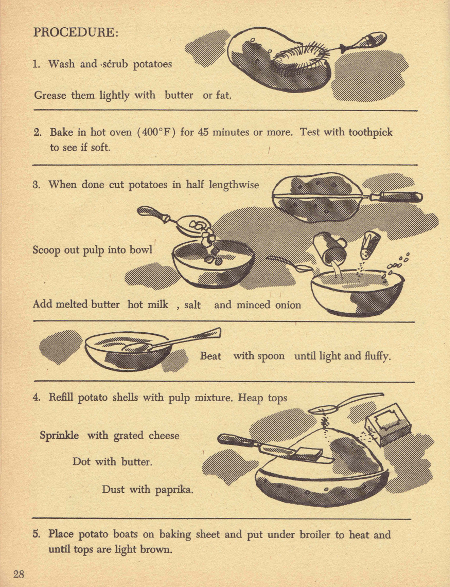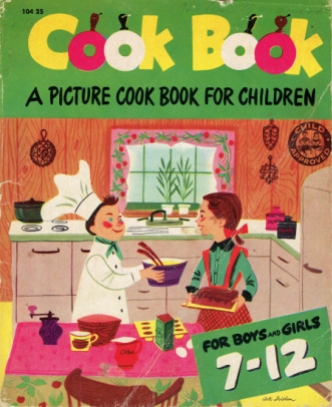For the next few posts, I’m going to be reviewing cookbooks for children. I’ve managed to collect quite a few in my travels, and I’m interested in seeing how they’ve evolved over time. I’ll be looking at the types of recipes in the books, the complexity of those recipes, how the information is delivered, and whether the books provide any extra information like how to set the table, safety, or etiquette.
The first book I’m looking at is Cook Book: A Picture Cook Book for Children by Helen Jill Fletcher. Curiously, the title on the title page reads “Things to Cook” instead of using the title on the cover. This book was published in 1951 as part of a series of books for this age group published by Paxton-Slade in the early 50s.
Written for children ages 7-12, the pages of this book are rather thick and coarse, like the pages of a child’s coloring book. There are step-by-step illustrations for each recipe; however, some of the illustrations are a little unclear without reading the accompanying text.

After the title page and table of contents is a section titled “What we must know about measurements”. The pages show some tips for accurate measuring; for example, it instructs children to measure dry ingredients before measuring liquids or fats and to butter the measuring cup to keep molasses from sticking. Next is a page of measurement equivalents and a chart explaining temperature equivalents to subjective oven temperatures. The chart shows that a slow oven equates to a 250-325 degree oven. A moderate oven is 325-400 degrees. While the terms “slow oven,” “hot oven,” and “very hot oven” are rarely used any more, I have seen them in a lot of older cookbooks. This cookbook was published at a time when people were transitioning from wood and coal fired ovens to ones with more accurate temperature controls. I’m guessing that the inclusion of subjective temperature equivalents was to help make the book accessible to those without temperature controls on their ovens or to help kids learn how to read older cookbooks.
Next is a primer on basic cooking skills. They review a few common skills needed to complete the recipes, including: creaming butter and sugar, beating, separating egg whites, chopping, dicing, and cutting. Then there’s a section on how to set a table, and some suggested menus.
The recipes are fairly kid friendly with no complicated or rare ingredients. Most recipes have between four and six ingredients. The most complicated recipes are the gingerbread men which calls for 11 ingredients. The recipes to lean a bit on the sweet side. Half of the recipes are baked goods, sweetened beverages, or sweet snacks. The rest are kid friendly appetizers, entrees, salads, snacks, and side dishes. Oddly, none of the recipes contain chicken. This is probably because chicken was expensive for most people until battery farming became more prevalent in the 70s and 80s.

This book attempts to be inclusive of both boys and girls. Each recipe is given either a boy’s name or a girl’s name. Thirteen of the recipes are associated with girl’s names and twelve with boy’s names. I tried to discern whether there was some sort of pattern to the naming of the recipes, but aside from things with wieners named for boys (Billy’s Franks and Beans and Wimpy’s Bacon-Wiener) and Hector’s He-Man Hamburgers, there really isn’t a pattern. There are salads, desserts, and vegetable dishes all with boys’ and girls’ names.

One thing that sets this book apart from other children’s cookbooks in my collection is that there is absolutely nothing about safety. At the very least, most books will have a section at the front warning kids that ovens are hot and that knives are sharp, but this book has nothing.
To see if there is anything truly hazardous in this book and to create a baseline for other books, I compiled a list of activities that I think can be particularly hazardous for children in the kitchen: deep-frying, pan-frying, making candy with super-hot sugar, using sharp implements, using beaters/mixers/blenders, and using a double boiler. I didn’t include things like boiling water or taking hot pans from the oven because they are pretty much standard when cooking; although, I imagine they are the cause of most kitchen-related emergency room visits for children. Keeping this list in mind, I found that most of the recipes in this book are fairly innocuous. There are a few recipes that require a double boiler and most recipes require cutting or chopping, but other than that there isn’t really anything dangerous. I still find it odd that there isn’t anything about kitchen safety in the book.

Most of the children’s cookbooks I’ve seen from the mid-century forward contain a recipe for hamburgers. This recipe seems more like a meatloaf than what I think of as a hamburger. It calls for ground beef, egg, breadcrumbs, catsup, salt, and cooking fat.

The directions to make this merry-go-round cake are in the book as well. It has a plain yellow cake for the base. The animals are animal crackers, candy sticks are used as the uprights, and the canopy is paper cut into a circle with a radial slit so it can be shaped into a cone. Making decorative cakes seems to be a mainstay of cookbooks for this age group.

Not all of the illustrations are clear. It took me forever to understand that the top picture is a scrub brush cleaning a potato. I though it was an amoeba on a stick. This is page is from the recipe for potato boats, essentially twice-baked potatoes.


